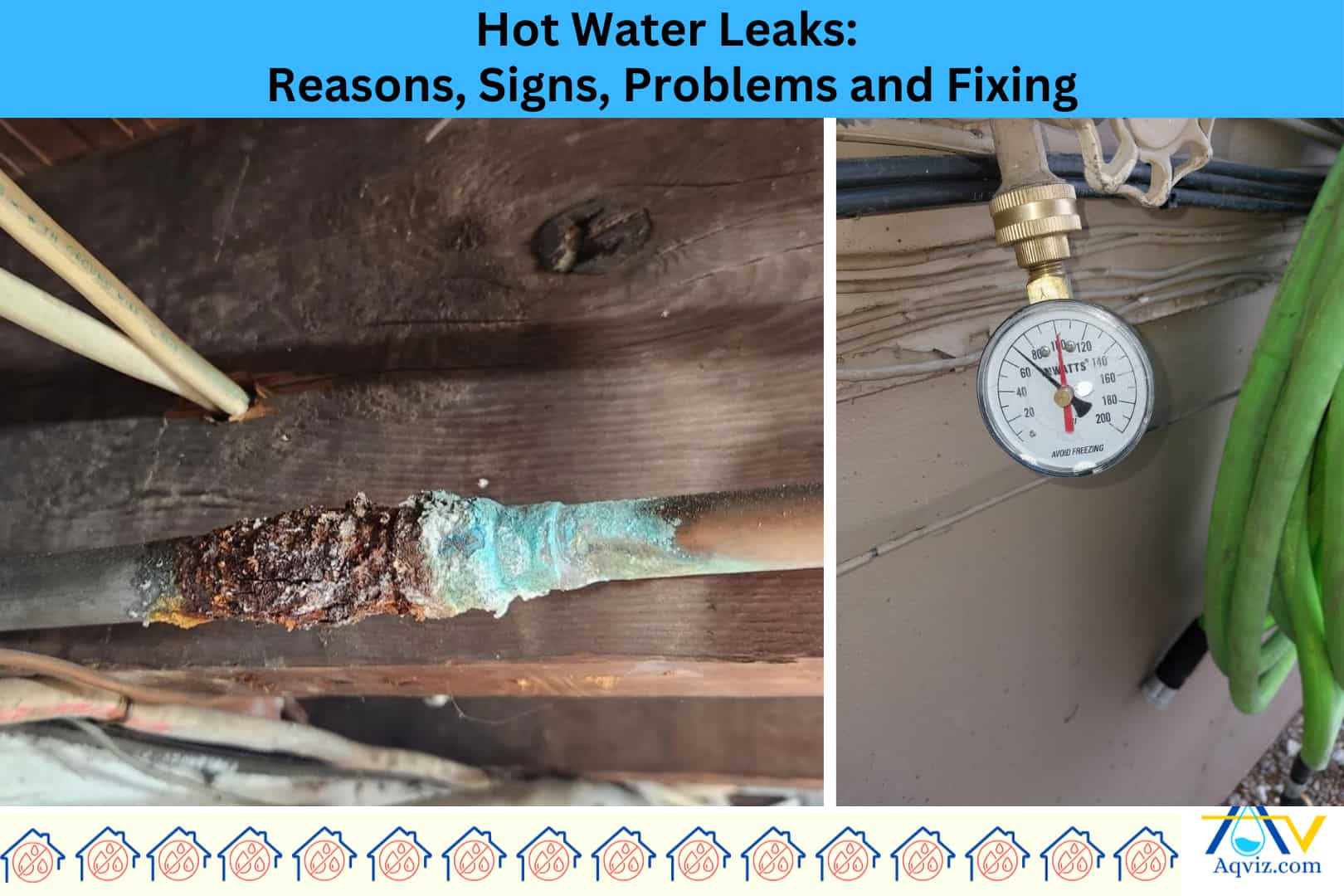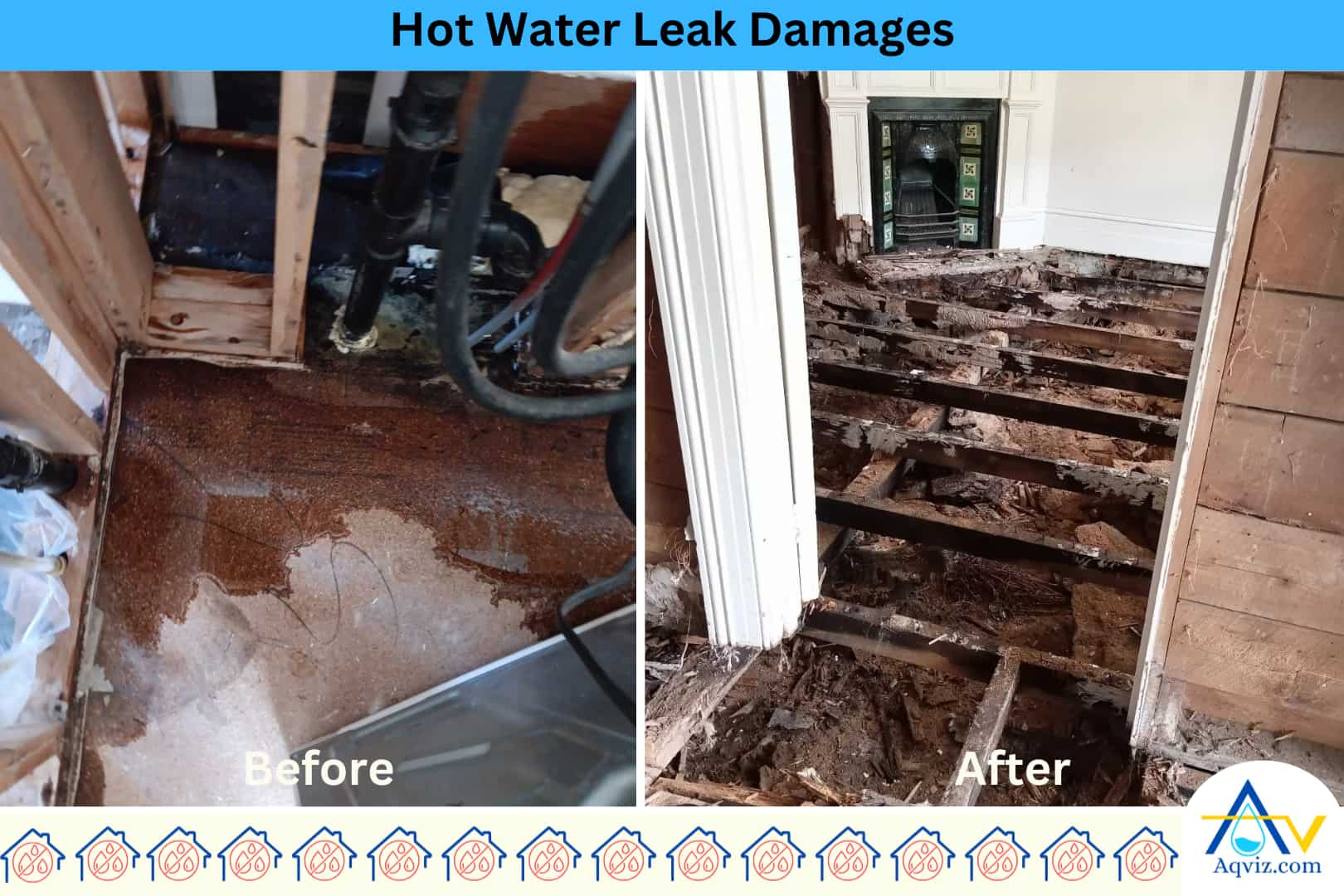Hot Water Leak in Bathroom: Reasons, Signs, Problems and Fixing

A hot water leak in the bathroom is an unintended escape of heated water and steam from supply lines, mixer valves, or concealed plumbing joints. Bathroom hot water leaks due to worn pipe joints, thermal expansion stress, corroded fittings, faulty mixer valves, and damaged flexible connectors.
You can observe the hot water leaking using these 6 signs, such as warm spots on floors or walls, rising utility bills, steam buildup without visible water, sound of running water, discolored or grout lines, and loose or soft tiles in the bathroom.
When hot water is leaked pronlong it may cause structural damage, higher utility bills, mold growth, tile loosening, and scalding risks. To minimize the impact of hot water leaking, you should waterproof all wet areas in the bathroom. As well as you should use heat-resistant plumbing materials, install expansion loops or joints, and perform routine plumbing inspections
When there is a hot water leaking in the bathroom, you should fix it. Aqviz waterproofing experts have prepared a complete guide to repair/fix a hot water leak in the bathroom. This will help you to use the tools correctly and follow the correct steps properly. If you have any problem, don’t hesitate to reach Aqviz support.

What is a Hot Water Leak in the Bathroom?
A hot water leak in the bathroom is an unintended escape of heated water and steam from supply lines, mixer valves, or concealed plumbing joints. Hot water leak in the bathroom usually happens due to worn pipe joints, thermal expansion stress, corroded fittings, faulty mixer valves, and damaged flexible connectors.
You can observe hot water leaking behind the ceramic tiles, beneath bathtub enclosures, or inside wall cavities in the bathroom where CPVC, PEX, or copper pipes carry hot water. Hot water and steam wear and expand the piping systems. Prolonged hot water leaks cause peeling paint, tile delamination, mold growth, and increased utility bills.
To prevent long-term hot water leaking damage, Aqviz experts recommend applying cementitious waterproofing membranes beneath tile bedding, sealing around plumbing penetrations with polyurethane sealants, and conducting pressure tests during renovations. These proactive waterproofing methods help contain moisture from hot water leaks before it seeps into absorbent materials like gypsum boards or wooden subfloors.
Read More About: Bathroom Waterproofing: Everything You Should Know
What are the Reasons for Leaking Hot Water in the Bathroom?
There are 4 reasons for leaking hot water in the bathroom, including worn pipe joints, thermal expansion stress, corroded fittings, faulty mixer valves, and damaged flexible connectors.
- Worn pipe joints: Over time, joints in CPVC, PEX, or copper pipes in the bathroom plumbing system carrying hot water degrade due to constant heat exposure. This causes hot water to leak behind walls or under floors.
- Corroded fittings: How water is leaking due to corrosion of metals like brass, galvanized steel, or even brass-to-copper connections. This causes the pipes and joints to weaken and increases the leaking possibility over time.
- Faulty mixer valves: A failing thermostatic mixing valve (TMV) or shower cartridge can leak internally or fail due to mineral deposits and heat pressure. This can cause a leak of hot water in the bathroom.
- Damaged flexible connectors: Compromised stainless-steel hoses or rubber supply lines can crack or blister from prolonged heat exposure. This cause to leak how water in the bathroom.
How to Find Hot Water Leaking in the Bathroom?
You can find hot water leaking in the bathroom by observing these 6 signs, such as warm spots on floors or walls, rising utility bills, steam buildup without visible water, sound of running water, discolored or grout lines, and loose or soft tiles in the bathroom.
- Warm spots on floors or walls : If you feel unusual warmth under tiled floors or on lower wall surfaces, it can be a strong signal that hot water is escaping from concealed supply lines or fittings beneath the bathroom wall or floor.
- Rising utility bills : When you notice a sudden and unexplained increase in your gas or electric bill, it can be strong evidence that your water heater is running continuously due to a hidden hot water leak.
- Steam buildup without visible water use : Occasionally, if you observe steam or humidity in the bathroom even when no fixtures are running, it could indicate that hot water is leaking behind the walls or beneath the flooring..
- Sound of running water : If you hear a continuous hissing or trickling noise inside walls or under the floor, it is a strong indicator of a pressurized hot water line leaking in a concealed location.
- Discolored tiles or grout lines : When you observe yellowish or rusty staining around the base of tubs, vanities, or walls, it is strong evidence that hot water, often containing minerals, is leaking and staining porous surfaces.
- Loose or soft tiles : If you feel tiles shifting or flexing underfoot in warm zones, it is a strong indication that a hot water leak has weakened the adhesive beneath, allowing moisture to loosen the tile bond.
What are the Impacts of Hot Water Leaking into the Bathroom?
There are 5 problems due to hot water leaking in the bathroom such as structural damage, higher utility bills, mold growth, tile loosening, and scalding risks. Persistent hot water leakage affects both building components and occupant safety severely.
- Structural damage to subfloors and walls : Continuous hot water leakage seeps into wooden subfloors, gypsum boards, and tile bedding, softening structural components. This leads to floor sagging, wall warping, and long-term loss of structural integrity in the bathroom.
- Higher utility bills : Hot water leaking from pipes or fittings forces the water heater to run continuously. This unnecessary energy consumption significantly increases gas or electricity bills, causing financial strain and reducing overall system efficiency.
- Mold and mildew growth : Hot water leakage creates a warm, damp environment ideal for mold growth behind tiles and cabinets. This promotes unhealthy indoor bathroom air quality and increases maintenance costs.
- Tile and adhesive failure : Hot water leaks weaken tile adhesives and grout joints. Over time, this leads to loose or hollow tiles and surface detachment, lowering the bathroom’s finish quality and safety.
- Scalding and slip hazards : Leaking hot water can pool unnoticed on the bathroom floor. This not only increases the risk of slipping but also creates scalding hazards, especially for children and elderly users.

How to Minimize the Impact of Hot Water Leaking in the Bathroom?
To minimize the impact of hot water leaking in the bathroom, you should waterproof all wet areas and follow the 4 key preventive maintenance steps below.
- Waterproof the bathroom floor and walls : Installing cementitious or liquid waterproof membranes beneath bathroom tiles and around plumbing fixtures helps to prevent hot water from penetrating the substrate. This stops bathroom seepage into the subfloor and protects against long-term moisture damage and mold.
- Use heat-resistant plumbing materials : Installing CPVC, PEX-AL-PEX, or other heat-rated pipes for the bathroom helps to prevent cracks or joint failures caused by thermal expansion. These materials help reduce the chances of leaks under hot water pressure.
- Install expansion loops or joints : Adding expansion loops in long hot water lines in the bathroom helps to absorb thermal movement. This minimizes pipe stress and helps prevent leaks at elbows, tees, or straight pipe runs due to heat fluctuations.
- Perform routine plumbing inspections : Regularly check the bathroom for leaks around valves, mixers, and supply lines to help detect early signs of wear. This helps to start early repairs of the plumbing lines.
How to Fix Hot Water Leaking in the Bathroom?
To fix hot water leaking in the bathroom, you should follow the 6-step guide below . Aqviz experts always follow these steps in all of our repair and renovation projects. These important steps help you use the tools correctly and complete the task with safety and efficiency.
- Turn off the water supply and power to the heater: You should always begin by shutting off the main water supply valve and switching off the breaker to the water heater. This step ensures a safe working condition by preventing pressurized flow and hot water burns.
- Locate the source of the leak: Then you should use a thermal imaging camera and moisture meter, so you can scan behind walls or under floors to detect temperature changes and water presence. This helps you identify if the leak is from a PEX joint, mixer valve, or copper pipe.
- Access the leaking pipe or fitting: Then you should carefully remove tiles, wallboard, or paneling using a multi-tool with a carbide blade to expose the plumbing. In tight areas, you can use an oscillating saw to access concealed hot water lines without damaging adjacent structures.
- Repair or replace the damaged pipe section: If the leak is on PEX, you can use a PEX cutter, crimp tool, and sharkbite or crimp fittings to replace the faulty section. For copper lines, you can use a pipe cutter, flux, and a soldering torch to sweat a new joint. You should always check that joints are clean and properly seated before sealing.
- Pressure test the repair: Before closing the wall, you should turn on the water and check for leaks using a pressure gauge and a dry tissue wrap around the joints. This test confirms that the repaired section is sealed and holds under hot water pressure.
- Reinstate waterproofing and close the access: After confirming the leak is fixed, apply a liquid waterproof membrane around the repaired area and reinstall the cement board, tiles, or water-resistant drywall. This step protects the area from future water infiltration and restores structural integrity.
Aqviz Experts have investigated all of the bathroom water damages and listed out the 8 most common water damage in the bathroom and prepared a complete guide for each water problem with including reasons, signs, problems, and how to fix it properly as an expert. So we highly recommend you to refer to all of these 8 bathroom problems.
- Bathroom Sink Drain Leak
- Bathroom Faucet Leak
- Toilet Leak
- Bathroom Sink P Trap Leak
- Bathtub Overflow
- Cracked Shower Tray
- Bathroom Broken Tiles
Can Bathroom Mold be Killed by the Hot Water?
No, bathroom mold cannot be fully killed by only hot water. While hot water may loosen surface mold or wash away visible spots, it doesn’t destroy mold spores embedded in grout, drywall, or porous materials.
At Aqviz, we’ve tested this during cleanups, hot water reduces surface buildup but does not stop regrowth. To kill mold effectively, we always use mold-killing cleaners like bleach, hydrogen peroxide, or commercial biocides, followed by proper drying and waterproofing.
Is Bathroom Mirror Fogging Increased with the Hot Water?
Yes, bathroom mirror fogging increases with hot water use. When you run hot water in the shower or sink, it creates steam that fills the air. As the warm, moisture-filled air contacts the cooler mirror surface, it condenses into tiny droplets, causing fogging.
Read More: 7 Ways to Stop Bathroom Mirror from Fogging Up
At Aqviz, we see this often in bathrooms without proper ventilation or exhaust fans . The more hot water you use during long showers, the more fog builds up on the mirror surface.
How to Use Hot Water in the Bathroom Properly?
To use hot water in the bathroom properly, you should control the temperature, reduce usage time, and maintain plumbing safety.
- Set the heater to a safe temperature between 49-54°C (120-130°F)
- Use an exhaust fan during hot showers
- Check fittings regularly
- Use water-saving fixtures
Should You Waterproof Near The Hot Water Source?
Yes, you should always waterproof near the hot water source in the bathroom. Hot water lines, mixers, and shower valves are common leak points due to thermal expansion, pipe movement, or seal failure. Waterproofing in these areas prevents hidden mold growth, surface damage, and long-term structural issues in the bathroom over time.
Can Hot Water Damage the Bathroom Waterproofing Layer?
Yes, hot water can damage the bathroom’s waterproofing layer if you use the wrong material, low-quality material, or improperly applied material for the waterproofing process. These membranes can break down due to constant heat and steam exposure in the bathroom.
